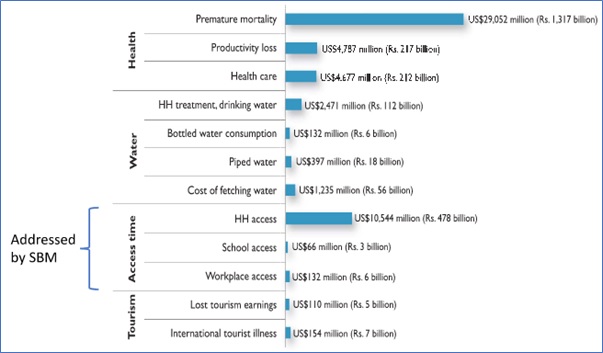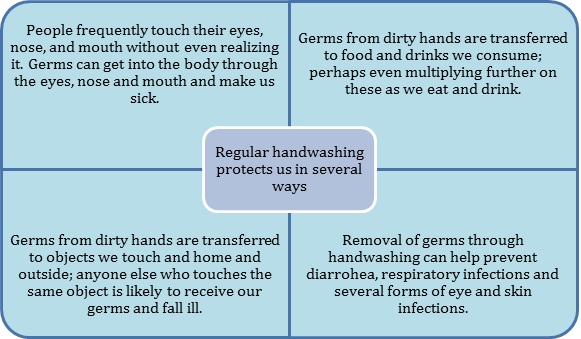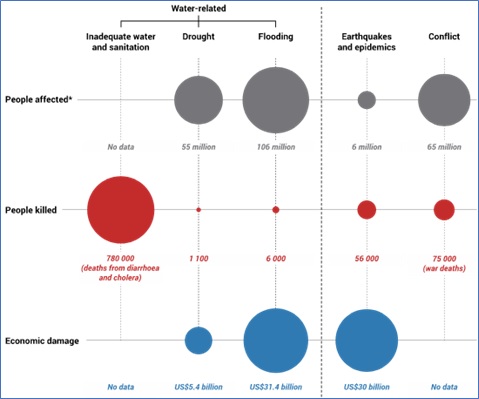1. Less water, higher demand
India has about 4% of the world’s freshwater resources but houses approximately 17.6% of the world’s population. According to a NITI Aayog report[1], 600 million Indians face high to extreme water stressand about 200,000 people die every year in India due to inadequate water, sanitation and hygiene. In 2016, India’s per person disease burden due to unsafe water and sanitation was 40 times higher than in China and 12 times higher than in Sri Lanka. With an annual per capita water availability of close to 1,000 m3, India is one of the most water stressed countries in the world. According to a World Bank report[2], India’s land would need to generate four times more GDP to achieve China’s GDP, and India’s irrigation water would need to produce five times more agricultural GDP to achieve China’s level of water productivity[3]. Water pollution is a major concern, with less than 40% of the municipal wastewater being treated in the country. Around 302 polluted stretches totalling 12,363km, on 275 rivers have been reported[4].
Demand for water is projected to nearly double by 2050, rising in all sectors, particularly in the industrial and domestic sectors, placing pressure on agriculture, which currently accounts for 90 percent of water use. Climate change will further exacerbate India’s water resources management challenges, affecting not only water availability but also water quality and demand. A WWF report[5], suggests that out of total gross credit exposure of Indian banks, more than 39% is in such sectors where water risks are significant. With about 25 million tube wells, groundwater economy uses about almost a quarter of the energy produced in the country.
2. Water is critical to life but can be life-threatening too
Globally, far more people die of inadequate drinking water and sanitation services than from war, epidemics, floods, earthquakes or droughts (Figure 1).The World Bank estimates that 21 percent of communicable diseases in India are linked to unsafe water and the lack of hygiene practices. Further, more than 500 children under the age of five die each day from diarrhoea in India alone. However, these numbers mask significant inequities between and within states, regions, communities and even neighbourhoods – the poor, women, girl children and the socio-economically underprivileged feel the impact more than others.
Over 50% of the rural households still rely upon non-piped sources of water for drinking[6]; these sources such as tube well, handpumps and wells can be sources of biological and/or chemical contamination. Even in urban India, over 20% of households rely on such unclean sources for their drinking water needs. Over 65% of all households (72.8% rural and 50.9% urban) do not treat the drinking water at home before consuming it. This is important as even having access to piped water supply doesn’t necessarily translate into access to safe water. A study[7] on quality of piped water supply by the Bureau of India Standards, concluded that of the 21 cities covered by the study, none of the water samples in Delhi and thirteen other state capitals[8] complied with the requirements as per the Indian Standard for Drinking Water.
Figure 1: Average annual impact from inadequate drinking water and sanitation services, water-related disasters, epidemics and earthquakes, and conflicts (Reproduced from UN World Water Development Report 2019, page 12)
3. Poor water and sanitation services worsen poverty in India
The low-income households spend as much as 15 percent of their income as coping costs for inadequate, erratic and unsafe water supply, in contrast to 1 percent for the high-income households[9]. Added to this is the time and resources spent on collection of water, which is disproportionately borne by women and girl children. The cost of fetching water is estimated to be equivalent to 150 million person-days a year, costing the Indian economy INR 10 billion in lost production.
A World Bank study[10] calculated that inadequate sanitation costs India INR 2.4 lakh crore in FY 2006-07 values (Figure 2). These costs arose due to impacts related to health, domestic water, time to access sanitation, and tourism sector. While the Swachh Bharat Mission has mostly addressed the “access time impacts” which comprised less than 20% of the entire costs, the other three impacts comprising over 80% of the inadequate sanitation costs will continue to plague the economy unless all faecal waste is safely treated, clean water is provided and public/community toilets are kept clean and accessible, including for women, children and third gender. The biggest beneficiaries of 100% sanitation will be the poor, as the poorest 20 percent households bear the highest per capita economic impacts of inadequate sanitation in both urban and rural areas. Not surprisingly, diarrhoea in children below five years accounted for more than 47 percent (INR 824 billion, US$18 billion) of the total health-related economic impacts. This study estimates that a package of comprehensive sanitation and hygiene interventions[11] can result in averting 45 percent of adverse health impacts, and avoid all the adverse impacts of inadequate sanitation related to water, welfare, and tourism losses.
One gram of faeces can contain: 10,000,000 viruses, 1,000,000 bacteria, 1,000 parasite cysts and 100 parasite eggs. (World Health Organization)

Figure 2: Cost of inadequate sanitation – INR 2.4 trillion (lakh crore) in FY 2006-07 values (But are 2.5 times higher today accounting for inflation)
4. Good hygiene saves lives
There is a very strong link between water and hygiene as evidenced by such uses, among others: (i) drinking water, free of chemical and biological contamination; (ii) handwashing, before meals and after toilet use; (iii) bathing; (iv) washing of clothes and kitchen utensils; (v) washing during menstruation; (vi) cleaning of house; (vii) anal cleansing after defecation; and (viii) washing of food items before cooking or consuming them raw.
The practice of handwashing is still to be fully inculcated among the Indian households. Only 74% practice washing of hands with soap and water after defecation. The rest wash hands with water only or with water and ash/mud/sand, both not meeting the standard of clean washing of hands. The data for washing of hands before a meal is worse – only 36% wash using soap and water while the rest wash hands with water and ash/mud/sand, water only or do not wash at all. In both the cases, rural India fares worse than the urban areas[12]. There are several benefits of washing hands with soap (Figure 3) including improved health, reduced incidences of diseases, and spending less money on medical costs.
Handwashing can prevent about 30% of diarrhoea-related sicknesses and about 20% of respiratory infections such as colds and pneumonia. (US Centres for Disease Control and Prevention)

Figure 3: Washing hands can reduce the incidence of several diseases and keep us healthier
(Source: https://www.cdc.gov/handwashing/why-handwashing.html)
5. We can make a difference
Full and comprehensive benefits will accrue to individuals, households, communities and the country when there is a coordinated and complete adoption of good practices along with availability of safe and sustainable water and sanitation services for all. A set of recommendations is given below towards realizing the social, economic and health benefits:
- Development of water quality testing kits that are low-priced, easy to use, and easily available across cities and villages; training to women self-help groups on usage and follow up action, if required.
- Integration of hygiene and health curriculum in schools at primary level through theory and practice
- Supply of adequate clean and affordable water to all households, educational institutions, community places, and office and commercial buildings
- Availability of low-priced soap to the poor households, perhaps through the Public Distribution System
- Scientific and safe collection and treatment of 100% solid and liquid waste; train, encourage and provide an enabling environment to micro and small entrepreneurs to provide such services.
- Public campaigns on hygienic practices, including handwashing before meals and after toilet usage
- Encourage water use efficiency in agriculture, households and industry through regulations, incentives and public campaigns; lessons could be learnt from the strategies used in encouraging energy efficiency such as the BEE Star Rating System.
- Collection of disaggregated data (with respect to gender, age, income groups, caste, geography, etc.) and social inclusion analyses enabling better designedand targeted interventions.
References:
1. Composite Water Management Index, NITI Aayog, August 2019. Page i
2. World Bank Group (2018) India: Systematic Country Diagnostic: Realizing the promise of prosperity (Report No. 126284-IN)
3. Irrigation uses 688 bm3 in India and agricultural GDP is 17 percent of an approximate US$2 trillion economy while in China irrigation uses 355 bm3 and agricultural GDP is about 9.7 percent of an approximate US$10 trillion economy.
4. https://www.downtoearth.org.in/news/water/cleaning-india-s-polluted-rivers-59877
5. WWF India, 2019. Hidden Risks and Untapped Opportunities: Water and the Indian Banking Sector.
6. Report on Drinking Water, Sanitation, Hygiene and Housing Conditions in India, NSS 76th Round Survey, Government of India, page 19
7. Source: https://pib.gov.in/newsite/PrintRelease.aspx?relid=194516
8. Bengaluru, Bhopal, Chandigarh, Chennai, Dehradun, Gandhinagar, Guwahati, Jaipur, Jammu, Kolkata, Lucknow, Patna, Thiruvananthapuram
9. Amit, R.K. and Sasidharan, S. 2019, “Measuring affordability of access to clean water: A coping cost approach”, IIT Madras. Journal of Resources Conservation and Recycling, 410-417.
10. World Bank, “The Economic Costs of Inadequate Sanitation in India, 2006
11. This will include use of toilets by each person, hygiene promotion (including hand washing with soap and safe water management), and improved access to safe drinking water.
12. Ibid. NSS 76th Round Survey, page 39
(The Author is Independent Consultant; Water, Sanitation and Climate Change.The Views expressed are personal.)
Image Source: https://earth911.com
(The views expressed are the author's own and do not necessarily reflect the position of the organisation)


